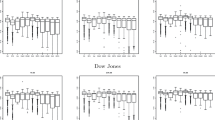Abstract
For two risks, X and Y, the Marginal Expected Shortfall (MES) is defined as \(\mathbb {E}[Y\mid X>F_{X}^{\leftarrow }(1-p)]\), where FX is the distribution function of X and p is small. In this paper we establish consistency and asymptotic normality of an estimator of MES on assuming that (X, Y ) follows a Conditional Extreme Value (CEV) model. The theoretical findings are supported by simulation studies. Our procedure is applied to some financial data.
Similar content being viewed by others
References
Beirlant, J., Goegebeur, Y., Segers, J., Teugels, J.: Statistics for Extremes: Theory and Applications. Wiley (2004)
Cai, J.-J., Einmahl, J.J.H.J., de Haan, L., Zhou, C.: Estimation of the marginal expected shortfall: the mean when a related variable is extreme. J. R. Stat. Soc. Ser. B 77(2), 417–442 (2015)
Cai, J.-J.C., Musta, E.: Estimation of the marginal expected shortfall under asymptotic independence. arXiv:1709.04285v1 (2017)
Das, B., Fasen, V.: Risk contagion under regular variation and asymptotic tail independence. arXiv:1603.09406 (2016)
de Haan, L., Ferreira, A.: Extreme value theory. Springer Series in Operations Research and Financial Engineering. Springer, New York (2006)
de Haan, L., Resnick, S.I.: On asymptotic normality of the hill estimator. Communications in Statistics. Stoch. Model. 14, 849–867 (1998)
Drees, H., Jannsen, A.: Conditional extreme value models: Fallacies and pitfalls arXiv:1606.02927v1 (2016)
Das, B., Resnick, S.I.: Conditioning on an extreme component: model consistency with regular variation on cones. Bernoulli 17(1), 226–252 (2011)
Heffernan, J.E., Resnick, S.I.: Limit laws for random vectors with an extreme component. Ann. Appl. Probab. 17(2), 537–571 (2007)
Kulik, R., Soulier, P.: The tail empirical process for long memory stochastic volatility sequences. Stoch. Process. Appl. 121(1), 109–134 (2011)
Kulik, R., Soulier, P.: Heavy tailed time series with extremal independence. Extremes 18, 273–299 (2015)
Resnick, S.I.: Heavy-Tail Phenomena. Springer Series in Operations Research and Financial Engineering. Springer, New York (2007). Probabilistic and statistical modeling
Rootzén, H.: Weak convergence of the tail empirical process for dependent sequences. Stoch. Proc. Appl. 119(2), 468–490 (2009)
van der Vaart, A.W., Wellner, J.A.: Weak Convergence and Empirical Processes. Springer, New York (1996)
Acknowledgements
The authors would like to thank all referees for their constructive comments.
Author information
Authors and Affiliations
Corresponding author
Rights and permissions
About this article
Cite this article
Kulik, R., Tong, Z. Estimation of the expected shortfall given an extreme component under conditional extreme value model. Extremes 22, 29–70 (2019). https://doi.org/10.1007/s10687-018-0333-9
Received:
Revised:
Accepted:
Published:
Issue Date:
DOI: https://doi.org/10.1007/s10687-018-0333-9



